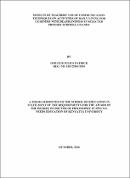| dc.contributor.advisor | | |
| dc.contributor.author | Omugur, Julius Patrick | |
| dc.date.accessioned | 2022-03-04T06:43:00Z | |
| dc.date.available | 2022-03-04T06:43:00Z | |
| dc.date.issued | 2016-10 | |
| dc.identifier.citation | Omugur, Julius Patrick (2016) Effects of teachers' use of communication techniques on activities of daily living for learners with deafblindness in selected primary schools, Uganda | en_US |
| dc.identifier.uri | https://kyuspace.kyu.ac.ug/xmlui/handle/20.500.12504/774 | |
| dc.identifier.uri | Find full text at Barclays library Rare section | |
| dc.identifier.uri | | |
| dc.description | xiii, 191 p. : ill. (some col.) ; | en_US |
| dc.description.abstract | The thesis concerns a study on the effects of the teachers' use of communication
techniques for achievement of daily living activities for learners with deafblindness in
primary Schools in Uganda. The thesis contains five chapters. That is Chapter one,
chapter two, chapter three, chapter four, and chapter five in that order. It aims to
identify and describe the extent to which the teachers' use of communication
techniques has had an effect on the learners' ability to acquire life skills during
activities of daily living in selected primary schools in Uganda. The word
deafblindness is used throughout the thesis, to imply learners who have both a hearing
and visual impairment that necessitates that teacher makes relevant adaptations for the
learners to participate in ADLs. The detail of the literature is discussed in chapter
two. The study was carried out in two districts, and in two government-aided primary
schools from Eastern and Mid-western regions of Uganda. The report adopted a
survey research design. A target population of 60 participants and a representative
population sample size of 30 participants constituted the study. Purposive sampling
technique was used to identify participants who taught learners with deafblindness in the
selected Schools of the study. The resulfs were obtained through descriptive analysis
using a triangulation approach, by observation, interviews and focus group
discussions. Data analysis followed categories and emerging sub-themes from the set
objectives. The study embarked on interviews and observations with the teachers
during indoor and outdoor ADLs. The theory of Social Interaction and the theory of
Language and Communication guided the study. These theories stated that; the
elements of language constitute its meaning to include aspects such as the use, context
and content and their interconnectivity during interactions and dialogue. A
conceptual frame work was developed in relation to literature reviewed. Purposive
sampling approach was used to identify study sites and participants. The study is
hoped to create awareness among communities about the education of learners with
deafblindness. The findings may benefit educationists and policy makers in the area
of learners with deafblindness. Study findings may create awareness among
stakeholders who might be of help to fill gaps identified. The study concluded that
teachers of learners with deafblindness were not doing well in the area of
communication that had an effect on the learners' participation achievements during
ADLs. The study recommends that teachers be encouraged to carry out exploratory
visits to Schools of similar settings to enable them share experiences and challenges.
Government should allocate reasonable funding to procure adapted teaching and
learning materials to support teachers in their work. The Uganda National
Curriculum Development Centre and other educational institutions cited in the thesis
to embrace flexibility during curricula adaptations and diversity in teacher training. | en_US |
| dc.description.uri | | |
| dc.description.uri | Find full text at Barclays library Rare section | |
| dc.language.iso | en | en_US |
| dc.publisher | Kenyatta University (unpublished work) | en_US |
| dc.subject | Effects | en_US |
| dc.subject | Teachers | en_US |
| dc.subject | Communication techniques | en_US |
| dc.subject | Learners | en_US |
| dc.subject | Deaf blindness | en_US |
| dc.subject | Schools | en_US |
| dc.title | Effects of teachers' use of communication techniques on activities of daily living for learners with deafblindness in selected primary schools, Uganda | en_US |
| dc.type | Thesis | en_US |

